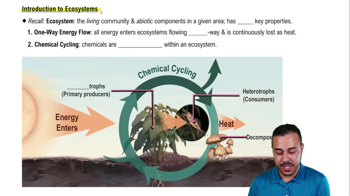Table of contents
- 1. Introduction to Biology2h 40m
- 2. Chemistry3h 40m
- 3. Water1h 26m
- 4. Biomolecules2h 23m
- 5. Cell Components2h 26m
- 6. The Membrane2h 31m
- 7. Energy and Metabolism2h 0m
- 8. Respiration2h 40m
- 9. Photosynthesis2h 49m
- 10. Cell Signaling59m
- 11. Cell Division2h 47m
- 12. Meiosis2h 0m
- 13. Mendelian Genetics4h 41m
- Introduction to Mendel's Experiments7m
- Genotype vs. Phenotype17m
- Punnett Squares13m
- Mendel's Experiments26m
- Mendel's Laws18m
- Monohybrid Crosses16m
- Test Crosses14m
- Dihybrid Crosses20m
- Punnett Square Probability26m
- Incomplete Dominance vs. Codominance20m
- Epistasis7m
- Non-Mendelian Genetics12m
- Pedigrees6m
- Autosomal Inheritance21m
- Sex-Linked Inheritance43m
- X-Inactivation9m
- 14. DNA Synthesis2h 27m
- 15. Gene Expression3h 20m
- 16. Regulation of Expression3h 31m
- Introduction to Regulation of Gene Expression13m
- Prokaryotic Gene Regulation via Operons27m
- The Lac Operon21m
- Glucose's Impact on Lac Operon25m
- The Trp Operon20m
- Review of the Lac Operon & Trp Operon11m
- Introduction to Eukaryotic Gene Regulation9m
- Eukaryotic Chromatin Modifications16m
- Eukaryotic Transcriptional Control22m
- Eukaryotic Post-Transcriptional Regulation28m
- Eukaryotic Post-Translational Regulation13m
- 17. Viruses37m
- 18. Biotechnology2h 58m
- 19. Genomics17m
- 20. Development1h 5m
- 21. Evolution3h 1m
- 22. Evolution of Populations3h 52m
- 23. Speciation1h 37m
- 24. History of Life on Earth2h 6m
- 25. Phylogeny2h 31m
- 26. Prokaryotes4h 59m
- 27. Protists1h 12m
- 28. Plants1h 22m
- 29. Fungi36m
- 30. Overview of Animals34m
- 31. Invertebrates1h 2m
- 32. Vertebrates50m
- 33. Plant Anatomy1h 3m
- 34. Vascular Plant Transport2m
- 35. Soil37m
- 36. Plant Reproduction47m
- 37. Plant Sensation and Response1h 9m
- 38. Animal Form and Function1h 19m
- 39. Digestive System10m
- 40. Circulatory System1h 57m
- 41. Immune System1h 12m
- 42. Osmoregulation and Excretion50m
- 43. Endocrine System4m
- 44. Animal Reproduction2m
- 45. Nervous System55m
- 46. Sensory Systems46m
- 47. Muscle Systems23m
- 48. Ecology3h 11m
- Introduction to Ecology20m
- Biogeography14m
- Earth's Climate Patterns50m
- Introduction to Terrestrial Biomes10m
- Terrestrial Biomes: Near Equator13m
- Terrestrial Biomes: Temperate Regions10m
- Terrestrial Biomes: Northern Regions15m
- Introduction to Aquatic Biomes27m
- Freshwater Aquatic Biomes14m
- Marine Aquatic Biomes13m
- 49. Animal Behavior28m
- 50. Population Ecology3h 41m
- Introduction to Population Ecology28m
- Population Sampling Methods23m
- Life History12m
- Population Demography17m
- Factors Limiting Population Growth14m
- Introduction to Population Growth Models22m
- Linear Population Growth6m
- Exponential Population Growth29m
- Logistic Population Growth32m
- r/K Selection10m
- The Human Population22m
- 51. Community Ecology2h 46m
- Introduction to Community Ecology2m
- Introduction to Community Interactions9m
- Community Interactions: Competition (-/-)38m
- Community Interactions: Exploitation (+/-)23m
- Community Interactions: Mutualism (+/+) & Commensalism (+/0)9m
- Community Structure35m
- Community Dynamics26m
- Geographic Impact on Communities21m
- 52. Ecosystems2h 36m
- 53. Conservation Biology24m
53. Conservation Biology
Conservation Biology
Problem 16b
Textbook Question
Textbook QuestionScientists around the world are collaborating to understand how deforestation, climate change, and natural processes will interact to affect one of the most productive and biodiverse ecosystems on Earth. Journalists must be concise when reporting science news. Why might journalists and the public struggle to understand and discuss ecosystems ecology and global warming?
 Verified step by step guidance
Verified step by step guidance1
Identify the complexity of the topics: Ecosystems ecology and global warming involve complex interactions between biological, chemical, and physical processes that can be challenging to simplify without losing essential details.
Recognize the use of jargon: Scientific terms and jargon used in discussing ecosystems and climate change can be unfamiliar and confusing to the general public, making it difficult for journalists to convey the information clearly.
Understand the scale and scope: The global scale and the long-term impacts of issues like deforestation and climate change can be hard to visualize and relate to, which can lead to misunderstandings or underestimation of the urgency of these issues.
Acknowledge the variability and uncertainty: Scientific predictions about ecosystems and climate change often involve probabilities and uncertainties, which can be difficult to communicate effectively and can lead to skepticism or dismissal by the public.
Highlight the need for accurate and accessible information: Journalists must balance the need to provide accurate scientific information with the need to make their reports accessible and engaging to a broad audience, which can be a challenging task.
Recommended similar problem, with video answer:
 Verified Solution
Verified SolutionThis video solution was recommended by our tutors as helpful for the problem above
Video duration:
57sPlay a video:
Was this helpful?
Key Concepts
Here are the essential concepts you must grasp in order to answer the question correctly.
Ecosystem Ecology
Ecosystem ecology is the study of how living organisms interact with each other and their physical environment. It encompasses the flow of energy and nutrients through ecosystems, highlighting the interdependence of species and their habitats. Understanding these interactions is crucial for grasping the complexities of biodiversity and the impacts of environmental changes.
Recommended video:
Guided course

Introduction to Ecosystems
Climate Change
Climate change refers to significant alterations in temperature, precipitation, and other atmospheric conditions over extended periods. It is primarily driven by human activities, such as burning fossil fuels, leading to increased greenhouse gas emissions. The effects of climate change on ecosystems can disrupt species interactions, alter habitats, and threaten biodiversity, making it a critical topic in environmental science.
Recommended video:
Guided course

Pollution and Climate Change
Communication of Scientific Concepts
Effective communication of scientific concepts is essential for public understanding and engagement. Journalists often face challenges in simplifying complex ecological and climate science without losing essential details. This struggle can lead to misunderstandings among the public, making it difficult to grasp the urgency and implications of issues like ecosystem health and global warming.
Recommended video:
Guided course

Scientific Method

 3:56m
3:56mWatch next
Master Conservation Biology and Biodiversity with a bite sized video explanation from Jason Amores Sumpter
Start learningRelated Videos
Related Practice







































